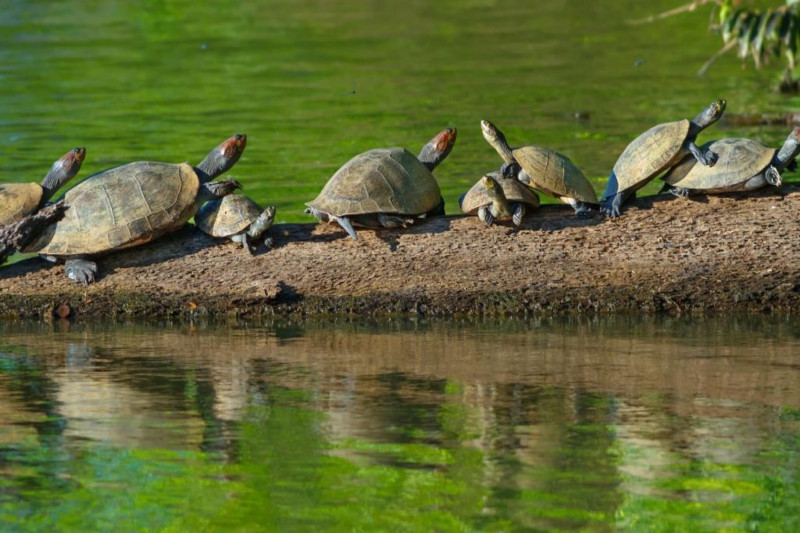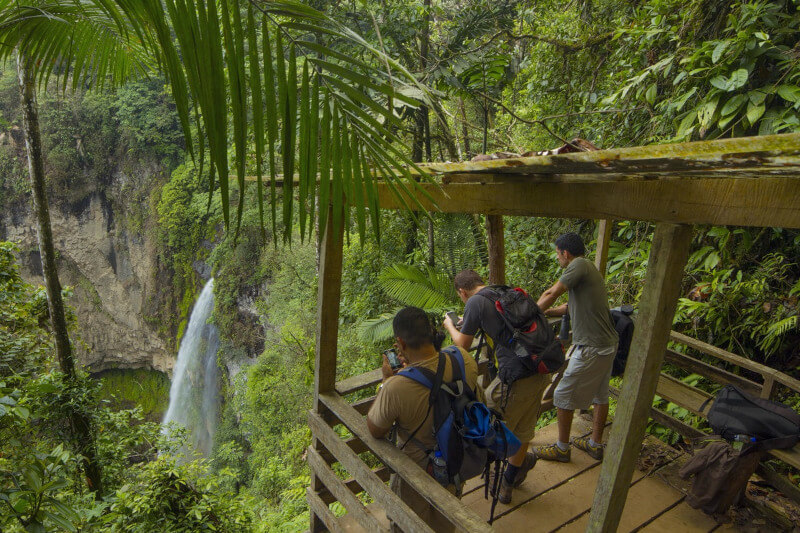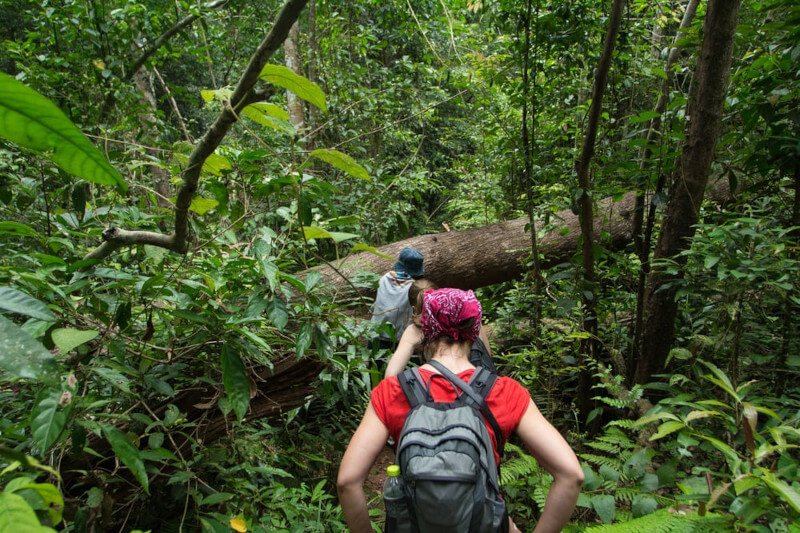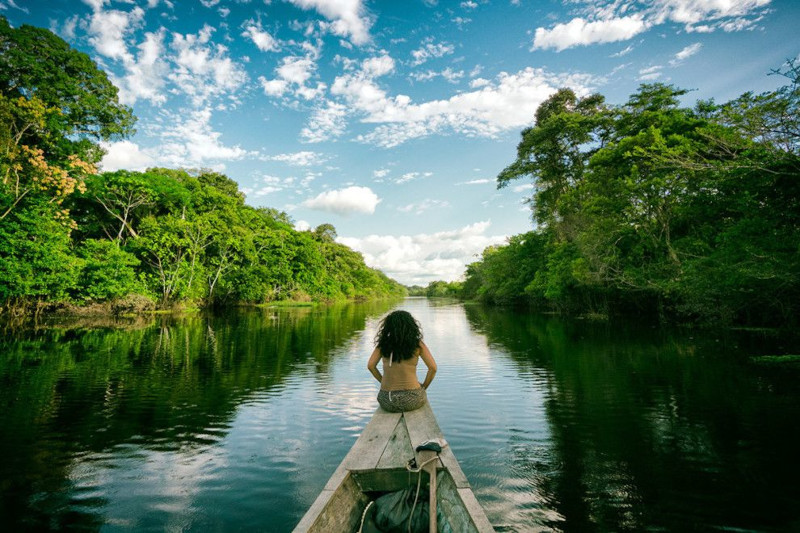The Manu Rainforest Peru is not just a destination; it’s an immersion into a world teeming with life. From the moment you step into this verdant paradise, you’ll be surrounded by the symphony of nature. Birds chirping, monkeys chattering, and the distant call of a jaguar create a soundtrack that is both exotic and enchanting. The dense canopy above filters sunlight, casting a kaleidoscope of greens and shadows that dance on the forest floor, and the air is thick with the earthy scent of the jungle, promising adventures around every corner.

Home to over 1,000 species of birds, 200 species of mammals, and countless insects and plants, Manu is a living testament to the richness of the Amazon rainforest. Walking through its dense trails, you’ll encounter vibrant macaws, playful capuchin monkeys, and perhaps even the elusive giant otter. Each step unveils a new marvel, whether it’s a rare orchid clinging to a tree trunk or a colorful poison dart frog camouflaged among the leaves.
For those who cherish nature, this is a place where every turn brings a new discovery. The diversity of life here is a reminder of the intricate interconnections that sustain our planet, offering countless opportunities for observation and study.
The Manu rainforest Peru is also a gateway to understanding the history and culture of the indigenous communities that have lived in harmony with nature for centuries. The Matsigenka, Yine, and Harakmbut people, among others, offer a unique perspective on sustainable living and cultural preservation. Engaging with these communities provides insights into their traditions, crafts, and daily life, enriching your travel experience immeasurably.
These communities have adapted ingeniously to their surroundings, using sustainable methods to hunt, fish, and gather, embodying a lifestyle that respects the delicate balance of their environment. Participating in their rituals or listening to their ancestral stories can be a transformative experience, reshaping how you perceive both nature and culture.

Embarking on a trip to the Manu rainforest requires careful planning and consideration. Here are some key aspects to ensure your adventure is both memorable and responsible. Preparing adequately will not only enhance your experience but also ensure that you contribute positively to the conservation efforts and local communities that depend on tourism for their livelihoods.
The best time to explore the Manu rainforest is during the dry season, from May to October. During this period, the weather is more favorable, and wildlife sightings are more frequent. The trails are less muddy, and the rivers are more navigable, making it easier to explore deeper into the forest. However, the rainforest’s beauty can be appreciated year-round, with each season offering its unique experiences. The wet season, though challenging, brings an explosion of life, with blooming plants and active wildlife, providing a different but equally captivating perspective.
Selecting the right Amazon tour is crucial for a fulfilling experience. Consider tours that emphasize responsible tourism, ensuring that your visit supports local communities and conservation efforts. Look for operators with knowledgeable guides who can offer deep insights into the flora, fauna, and cultural heritage of the region. These guides can enrich your journey with stories and facts that deepen your appreciation of the rainforest.
Additionally, choosing a tour that limits the number of participants can enhance your experience, offering a more intimate encounter with the wilderness.
Packing for the rainforest requires some forethought. Essential items include lightweight, breathable clothing, a good pair of hiking boots, insect repellent, binoculars for birdwatching, and a waterproof camera to capture the stunning vistas. Given the high humidity and frequent rainfall, quick-dry clothing and a reliable rain jacket are indispensable. Remember, the key is to travel light while being prepared for the unpredictable rainforest weather. Bringing along a guidebook on local flora and fauna can also enhance your experience, allowing you to identify and understand the myriad of species you’ll encounter.

Your journey through the Manu rainforest will be filled with awe-inspiring moments. Here are some highlights that you shouldn’t miss. Each destination within the park offers a unique glimpse into the complex ecosystems that define this region, promising unforgettable memories.
A serene oxbow lake nestled deep within the park, Cocha Salvador is a haven for wildlife enthusiasts. Here, you can take a canoe ride to spot giant otters, caimans, and a plethora of bird species. The tranquility of the lake, coupled with the vibrant life it supports, makes it a must-visit spot. As you paddle silently across the water, you’ll experience the thrill of seeing a giant otter family play or a caiman slide into the water, offering moments of pure wonder and connection with nature.
Witnessing the spectacle of hundreds of macaws and parrots gathering at the clay licks is a highlight of any trip to Manu. These colorful birds come to ingest the mineral-rich clay, creating a vibrant and noisy display that’s perfect for photography and observation. The clay licks provide essential minerals that help detoxify the fruits and seeds the birds consume, a fascinating example of nature’s balance. Watching this natural theater unfold is not only visually stunning but also a lesson in the ecological processes that sustain such diversity.
Spending time with the indigenous communities offers a profound understanding of life in the rainforest. Participate in traditional activities, learn about medicinal plants, and appreciate the intricate crafts that reflect their rich cultural heritage. Engaging with the locals provides a glimpse into their daily lives and the challenges they face in preserving their way of life amidst modern pressures. These interactions can foster a deeper respect for their knowledge and resilience, highlighting the importance of preserving their cultural legacy.

As a traveler, your choices can significantly impact the environment and local communities. Practicing responsible tourism ensures that the beauty and biodiversity of the Manu rainforest are preserved for future generations. By making mindful decisions, you can help protect this precious ecosystem while supporting the people who call it home.
Choose tour operators and accommodations that are owned or run by local communities. This not only supports the local economy but also ensures that your visit contributes positively to the region’s development. By prioritizing community-led initiatives, you help create sustainable income sources that incentivize conservation efforts. Engaging with local businesses also allows you to experience the region more authentically, gaining insights that larger operations might overlook.
Respect the natural environment by sticking to designated trails, reducing waste, and avoiding single-use plastics. Your mindful actions can help preserve the delicate ecosystem of the Amazon rainforest. Consider participating in conservation activities or workshops that educate you on the challenges facing the rainforest and ways you can contribute to its preservation. These efforts, though small, can collectively make a significant difference in maintaining the park’s ecological integrity.

Embarking on a Manu rainforest adventure is more than just a trip; it’s a journey into the heart of one of the world’s most awe-inspiring natural wonders. Whether you’re capturing the experience for a travel blog, curating a travel package, or seeking an enriching cultural encounter, the Manu rainforest offers a tapestry of experiences that will stay with you forever. With thoughtful planning and a commitment to responsible tourism, your adventure promises not only personal fulfillment but also a positive impact on the region’s ecological and cultural heritage.
Prepare yourself for an unforgettable journey, where every moment in the Manu rainforest is a step closer to understanding the intricate beauty of our natural world. As you plan your adventure, remember that the real treasure lies in the experiences you gather and the stories you’ll share. By embracing the principles of sustainability and respect, you ensure that the wonders of Manu continue to inspire and captivate future generations.
If you got any questions, please do not hesitate to send us a message. We reply within 24 hours!
+51 900 394 399
info@biomanuexpeditions.com
reservas@biomanuexpeditions.com
